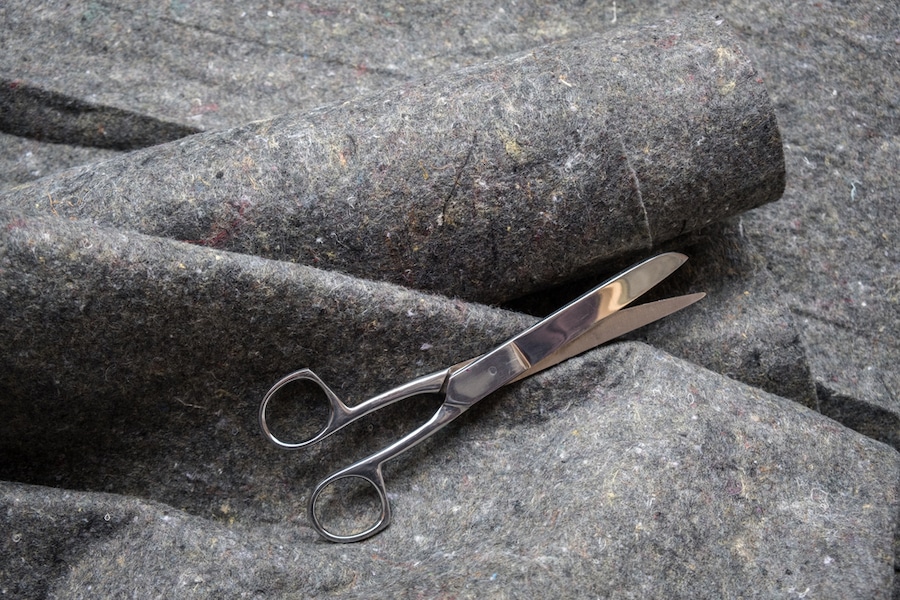Anytime you are working on a project that involves soil, the topic that comes up time and again is how to stabilize the ground for the project ahead.
More often than not, the dirt that is on-site is not ideal for the project being built. Soil that is too soft experiences problems with poor drainage and puddling, soil that is loosely packed erodes away with the weather, and mixing substrates without anything to separate them causes unpleasant compacting. These issues are all made exponentially worse if the ground needs to bear a great deal of weight, such as roads, embankments, driveways, parking pads, and even horse arenas.
In all these cases however, many of the worst problems can be fixed if the soil is given a structural boost. You can get that through the addition of geofabrics, geogrids, and even geocells.
But what is geotextile fabric, what exactly are these geotextile materials, how do they work and what is geotextile fabric used for? Keep reading to find out more.
What is Geotextile Fabric?
Geotextile is an umbrella term for a group of fabrics and two-dimensional materials specially engineered to be placed in the ground. The main purpose of these fabrics is that they provide an artificial layer of support to the existing soil helping with a variety of drainage and stabilization issues.
Currently, there are 4 main categories of geotextile on the market.
- Woven
Woven fabrics are typically used as a stabilization material due to their durability and tensile strength. These types of fabrics are made with woven monofilament, creating a basket-like appearance and texture to the surface of the fabric. This, in combination with their durability, allows for the use of stabilizing and reinforcing the ground– perfect for construction sites, embankments, and the like. - Non-woven
Non-woven geotextiles are the softer and weaker cousin to their woven counterparts. Because this fabric does not have as high of a load-bearing capacity, they are most often used as simple soil separation apparatuses– allowing for separation, filtration, and erosion control. - Polyspun
An even lighter variety of textile, Polyspun varieties are most often used as landscape fabric. Made by thermally binding polyester materials together, this fabric is porous and dark, allowing essential nutrients, water, and ventilation to pass through the fabric to allow nutrition to the plants it supports. - Spunbond
Like Polyspun fabrics, these are most commonly used in landscaping where separation is needed, but not support or reinforcement. The making of these fabrics also applies heat to filaments that are spun together into a roll.
While these fabric options are popular, they are not your only choices. Also within this category are a material called geogrids. These materials are two-dimensional, like fabrics, but build specifically to provide support and reinforcement. As such, they are thicker and move rigid and can effectively be stacked in layers for even more vertical support.
Having gone through a brief overview on the different materials available, the next question you must consider is which geofabric is right for your project and if they’re the right material at all.
Which Geotextile Should I Choose?
The type of project you are organizing will be what dictates the right geotextile fabric to use. The more support you need, the stronger textile is required.
As such, for construction plans, embankments, and any location that will bear a great deal of weight over its lifetime, woven fabrics and geogrids are your best choice. While non-woven fabrics are a close second, understand that they provide a greatly compromised level of support and are far more suited to projects where only separation is needed.
In the case of Polyspun and Spunbond fabrics, these felt-like materials have no place in soils which need to be reinforced. They will not only sag right along with the substrate itself, but potentially cause a larger mess in the long run. These textiles are for separation and drainage purposes only and have very few uses outside of landscaping projects that only require a light barrier to keep soil in place.
Unfortunately, some projects need even more support. For those that do, a final material can do the job.
When You Need the Highest Support
It is at this point many people begin to wonder if better options exist for projects requiring more support than any geotextile can provide. Here, geocells become the material of choice.
Like fabrics, geocells are plastic materials which are built to be placed underground. The difference is that while fabrics are thin and flexible, geocells provide rigid vertical support stronger than any other solution.
Geocells are three-dimensional, pocket-like structures that hold their substrate in individual compartments as seen in the image below.
These pockets are vertically enforced their entire length, meaning that when they are put under heavy pressure, the geocell itself prevents the soil within them from compacting or shifting. As such, geocells have the added benefit of promoting healthy, long-term drainage, with minimal need to replace your substrate of choice.
How Performance Footing Can Help
For those realizing their reinforcement needs are higher than originally anticipated, Performance Footing can step in to help.
As a family-owned, Arizona-based vendor of geocell technologies, Performance Footing is proud to offer unparalleled service and pricing for your project needs. Either purchase directly from the box below or give us a call with any question you might have at (877) 835-0878.
Have a question? Are you still wondering what is geotextile fabric? Don’t hesitate to reach out and we will help point you in the right direction.
